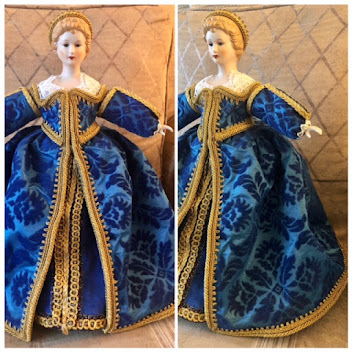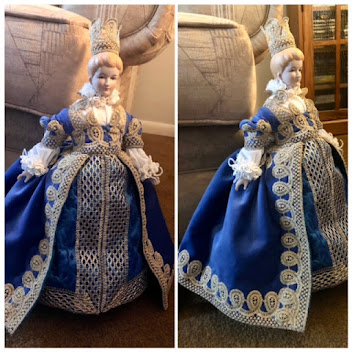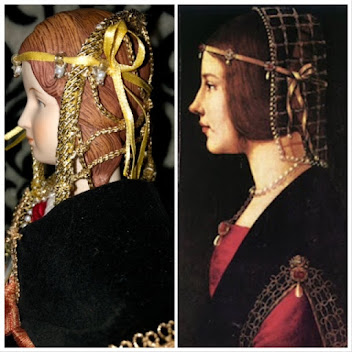16th and 17th Century evidence in Europe leans towards a use for dolls as a marriage negotiation item. For the noble and royal class of persons, as found in inventories of many notable royal families as per Mary Queen of Scots, Elizabeth I of England, Catherine de Medici, Isabelle d'Este, and Henry VIII of England. Fashion dolls within this purpose for the prospective bride to better have fashion information for the country of their prospective groom. They were used for fashion communication in this way in Europe. With the establishment of the colonies, dolls changed from an item of the wealthy to a more middle class item in the 18th Century.
Dolls' elaborate detailed nature was dictated by money invested in the finished product. If you wanted a doll with painted features, it would be the least expensive option. Carved simple dolls with painted features were known as Penny Dolls. I did procedure two for dressing using Colonial Williamsburg reproduction fabrics cotton prints. A doll with carved features would cost more as those take more time to create before the painting, assembling, and dressing process. Additionally if a doll was needing a human hair/ woolen or linen wig, that would need to be adhered to the doll after carving, assembling and painting. Wigs were not removable for those dolls that did have hair textures as a feature.

The use of fashion doll changes in the English colonies after their establishment, as ready made clothing was coming over fully made. Fashion plates were more popular and images from Europe were coming over regularly. Per interpreter information, over 50 ships a day in the 18th century with fabrics, clothing and other goods to sell to the colonies. So many colonists were able to clothe themselves well, which made the class system harder to distinguish by visual inspection of dress. As typical European Sumptuary laws didn’t seem to be enforced and people were dressed more to the manner of their work tasks. Also made mention by the interpreter that some may dress in a manner that they may want to be perceived. Which would not be out of ordinary practice when in European courts to secure a business need with the sovereign. Persons like courtiers may come to court dressed in a manner to impress on others but would be more challenging since Sumptuary laws would be prohibitive on colors, metals, jewels and fibers.

I am not sure what the Sumptuary laws were like in the English Colonies prior to the American Revolution for independence. A topic for more research, although I did secure some more information for my furthered study with this recent trip to Colonial Williamsburg. Seems that fashion dolls were more a child's plaything by this time and less used to convey fashion as per two centuries and a continent away. Even as a child's play thing, a doll could display some regard to current fashion and the detailed accessories and construction would give an idea of the initial investment made for the little lady.

The dolls I wanted to see in person from the online archive were not on exhibition. Although secured the contact information of the curator of that department. Eventually I will contact them to see about additional pictures and some information.
So more to come!!
Mairin







No comments:
Post a Comment